French film actor Roger Duchesne (1906-1996) appeared in 30 films between 1934 and 1957. He is best remembered as the silver-haired gangster Bob in Jean-Pierre Melville's Policier Bob le flambeur/Bob the Gambler (1956).
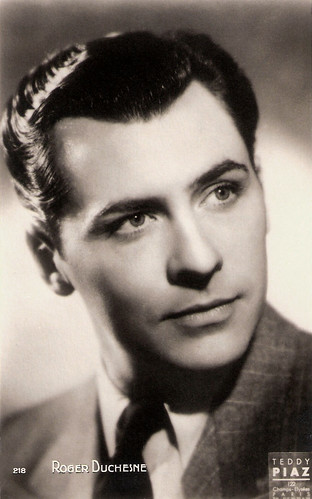
French postcard by Editions O.P., Paris, no 218. Photo: Teddy Piaz.
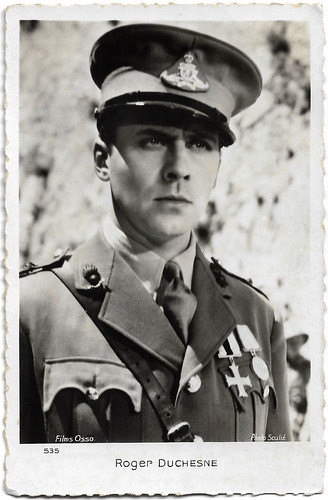
French postcard, no. 535. Photo Soulié / Les Films Osso. Roger Duchesne in Gibraltar (Fyodor Otsep, 1938).
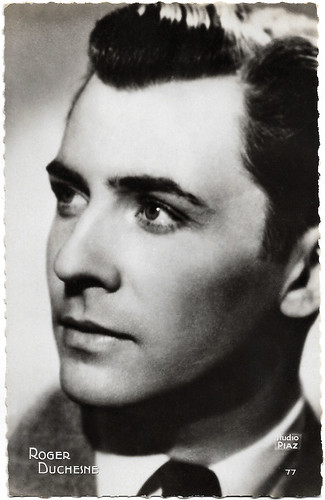
French postcard by Editions P.I., Paris, no. 77. Photo: Studio Piaz.

French postcard, no. 775. Photo: Studio Harcourt.

French postcard by Editions Continental, no. 108/A. Photo: Continental Films. Roger Duchesne in Adrien (Fernandel, 1943).
Roger Duchesne was born Roger André Charles Jordens in Luxeuil-les-Bains, France, in 1906. In 1934, he started his film career with Vers l'abîme/Towards the Abyss (Hans Steinhoff, Serge Véber, 1934) starring Raymond Rouleau and Brigitte Helm, a French language version of the Ufa production Die Insel/The Island (Hans Steinhoff, 1934).
He played his first lead in the spy film Les loups entre eux/The Wolves Among Them (Léon Mathot, 1936) opposite Jules Berry. He also co-starred that year in the innovative Le roman d'un tricheur/Confessions of a Cheat (Sacha Guitry, 1936) starring Sacha Guitry himself and his wife Jacqueline Delubac.
James Travers writes at French Films: "Regarded as one of Sacha Guitry’s best films, Le Roman d’un tricheur is a hugely entertaining comedy, featuring some unforgettable visual comic gags. Having no dialogue, the film is perhaps best described as a silent film with voice-over commentary, in which the film’s central character (the cheat, played by Guitry himself) narrates the story of his life." Another interesting film was the comedy Messieurs les ronds de cuir/The Bureaucrats (Yves Mirande, 1937) with Lucien Baroux and Arletty.
Duchesne also appeared in Le Golem/The Golem (Julien Duvivier, 1936). Hal Erickson notes at AllMovie: "Filmed in Czechoslovakia, this French-language adaptation of the oft-filmed Jewish folk tale The Golem was one of the most expensive productions ever made in that country. The story, which some have cited as a precursor to Frankenstein, is set in Prague's Jewish Ghetto. Fearing an anti-Semitic pogrom at the hands of Emperor Rudolf (Harry Baur), Rabbi Jacob (Charles Dorat) magically brings a statue to life to protect his people from harm."
In the espionage drama Gibraltar/It Happened in Gibraltar (Fyodor Otsep a.k.a. Fedor Ozep, 1938), he co-starred with Viviane Romance, and Erich von Stroheim, who also co-wrote the script. He also appeared in the melodrama Tempête Sur L'Asie/Storm over Asia (Richard Oswald, 1938) which featured Conrad Veidt as a soldier of fortune who spearheads an expedition in Mongolia in hopes of finding hitherto untapped oil reserves.

French postcard by Editions O.P., Paris, no. 81. Photo: Teddy Piaz.
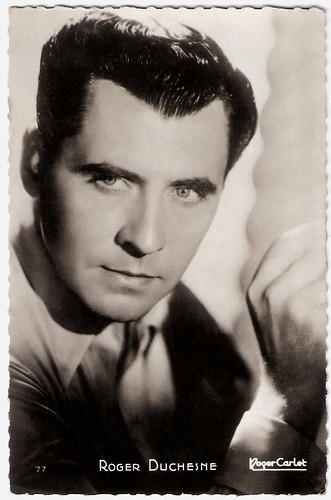
French postcard by Editions P.I., Paris, no. 77. Photo: Roger Carlet.
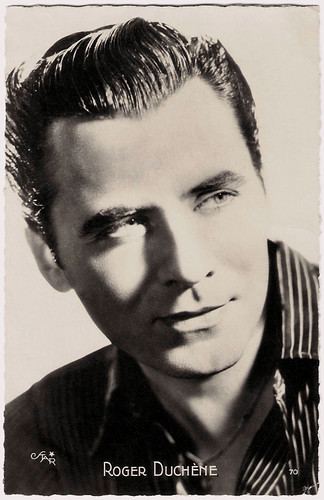
French postcard by Editions O.P., Paris, no. 70. Photo: Star.
Roger Duchesne continued to work after the Nazis had occupied France. He co-starred in Montmartre-sur-Seine (Georges Lacombe, 1941) starring Édith Piaf and Jean-Louis Barrault.
Other popular films during the war period were La femme perdue/The Lost Woman (Jean Choux, 1942) starring Renée Saint-Cyr, and the entertaining Fernandel farce Adrien (Fernandel, 1943). In September 1944, Duchesne was arrested while hiding in Paris, accused of having worked for the Gestapo. Then followed a gap in his film career of more than ten years.
Roger Duchesne made a great come-back with Bob le flambeur/Bob the Gambler (1956), a gangster film directed by Jean-Pierre Melville. He starred in the title role as the old, silver-haired gangster and gambler Bob, living in the Montmartre district of Paris, who experiences a run of bad luck that leaves him nearly broke. Duchesne turned Bob into a gentleman with scruples.
The film is often considered a Film Noir and precursor to the French Nouvelle Vague (New Wave) because of its use of a handheld camera and a single jump cut. The engaging and witty film was only the director's fourth film, made before Melville had access to the bigger budgets and the bigger stars (Jean-Paul Belmondo, Alain Delon) of his later pictures. However, Bob le Flambeur was not a great commercial success on its first release.
Duchesne made only one more film, Marchands de filles/Sellers of Girls (Maurice Cloche, 1957). In this crime drama, a poor woman (Agnès Laurent) finds herself the victim of a group of white slavers and drug smugglers. The criminals take the woman to South America, where she teams up with a mysterious stranger (Georges Marchal) to defeat her captors and find her way back home. Marchands de filles would be Roger Duchesne's final film. Not much is known about his further life. He died in 1996 in Les Mureaux, France, at the age of 90.
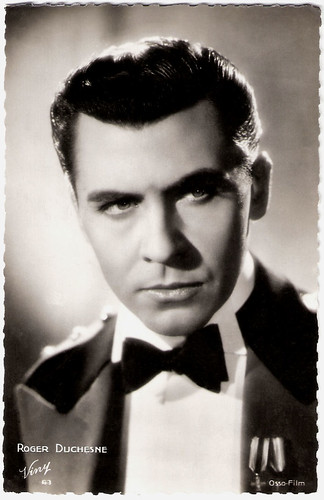
French postcard by Viny, no. 63. Photo: Osso-Film. Roger Duchesne in Gibraltar (Fyodor Otsep, 1938).
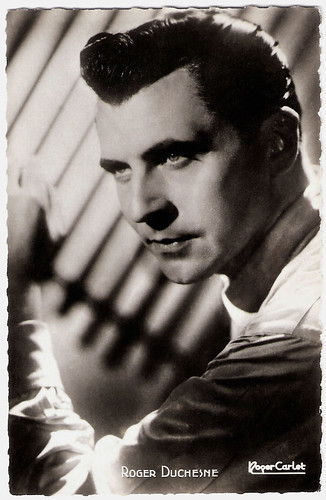
French postcard by Editions P.I., Paris. Photo: Roger Carlet.
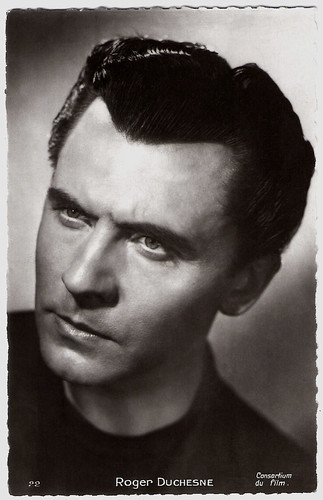
French postcard, no. 22. Photo: Consortium du film.
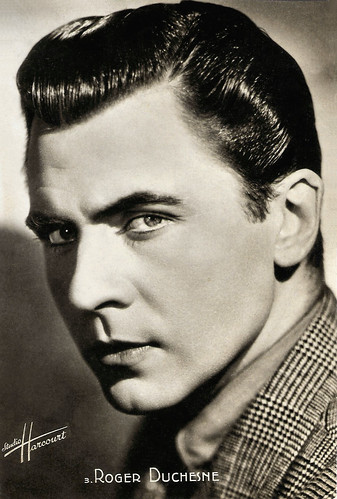
French postcard by S.E.R.P., Paris, no. 3. Photo: Studio Harcourt. Sadly, a former owner cut the edges of the card.
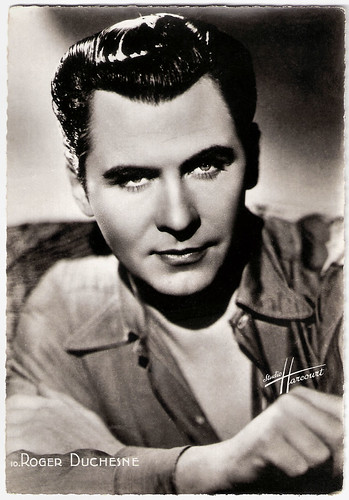
French postcard by S.E.R.P., Paris, no. 10. Photo: Studio Harcourt.
Sources: Hal Erickson (AllMovie), James Travers (French Films), Wikipedia (English and French) and IMDb.
This post was last updated on 1 February 2024.

French postcard by Editions O.P., Paris, no 218. Photo: Teddy Piaz.

French postcard, no. 535. Photo Soulié / Les Films Osso. Roger Duchesne in Gibraltar (Fyodor Otsep, 1938).

French postcard by Editions P.I., Paris, no. 77. Photo: Studio Piaz.

French postcard, no. 775. Photo: Studio Harcourt.

French postcard by Editions Continental, no. 108/A. Photo: Continental Films. Roger Duchesne in Adrien (Fernandel, 1943).
Soldier of fortune
Roger Duchesne was born Roger André Charles Jordens in Luxeuil-les-Bains, France, in 1906. In 1934, he started his film career with Vers l'abîme/Towards the Abyss (Hans Steinhoff, Serge Véber, 1934) starring Raymond Rouleau and Brigitte Helm, a French language version of the Ufa production Die Insel/The Island (Hans Steinhoff, 1934).
He played his first lead in the spy film Les loups entre eux/The Wolves Among Them (Léon Mathot, 1936) opposite Jules Berry. He also co-starred that year in the innovative Le roman d'un tricheur/Confessions of a Cheat (Sacha Guitry, 1936) starring Sacha Guitry himself and his wife Jacqueline Delubac.
James Travers writes at French Films: "Regarded as one of Sacha Guitry’s best films, Le Roman d’un tricheur is a hugely entertaining comedy, featuring some unforgettable visual comic gags. Having no dialogue, the film is perhaps best described as a silent film with voice-over commentary, in which the film’s central character (the cheat, played by Guitry himself) narrates the story of his life." Another interesting film was the comedy Messieurs les ronds de cuir/The Bureaucrats (Yves Mirande, 1937) with Lucien Baroux and Arletty.
Duchesne also appeared in Le Golem/The Golem (Julien Duvivier, 1936). Hal Erickson notes at AllMovie: "Filmed in Czechoslovakia, this French-language adaptation of the oft-filmed Jewish folk tale The Golem was one of the most expensive productions ever made in that country. The story, which some have cited as a precursor to Frankenstein, is set in Prague's Jewish Ghetto. Fearing an anti-Semitic pogrom at the hands of Emperor Rudolf (Harry Baur), Rabbi Jacob (Charles Dorat) magically brings a statue to life to protect his people from harm."
In the espionage drama Gibraltar/It Happened in Gibraltar (Fyodor Otsep a.k.a. Fedor Ozep, 1938), he co-starred with Viviane Romance, and Erich von Stroheim, who also co-wrote the script. He also appeared in the melodrama Tempête Sur L'Asie/Storm over Asia (Richard Oswald, 1938) which featured Conrad Veidt as a soldier of fortune who spearheads an expedition in Mongolia in hopes of finding hitherto untapped oil reserves.

French postcard by Editions O.P., Paris, no. 81. Photo: Teddy Piaz.

French postcard by Editions P.I., Paris, no. 77. Photo: Roger Carlet.

French postcard by Editions O.P., Paris, no. 70. Photo: Star.
Gestapo
Roger Duchesne continued to work after the Nazis had occupied France. He co-starred in Montmartre-sur-Seine (Georges Lacombe, 1941) starring Édith Piaf and Jean-Louis Barrault.
Other popular films during the war period were La femme perdue/The Lost Woman (Jean Choux, 1942) starring Renée Saint-Cyr, and the entertaining Fernandel farce Adrien (Fernandel, 1943). In September 1944, Duchesne was arrested while hiding in Paris, accused of having worked for the Gestapo. Then followed a gap in his film career of more than ten years.
Roger Duchesne made a great come-back with Bob le flambeur/Bob the Gambler (1956), a gangster film directed by Jean-Pierre Melville. He starred in the title role as the old, silver-haired gangster and gambler Bob, living in the Montmartre district of Paris, who experiences a run of bad luck that leaves him nearly broke. Duchesne turned Bob into a gentleman with scruples.
The film is often considered a Film Noir and precursor to the French Nouvelle Vague (New Wave) because of its use of a handheld camera and a single jump cut. The engaging and witty film was only the director's fourth film, made before Melville had access to the bigger budgets and the bigger stars (Jean-Paul Belmondo, Alain Delon) of his later pictures. However, Bob le Flambeur was not a great commercial success on its first release.
Duchesne made only one more film, Marchands de filles/Sellers of Girls (Maurice Cloche, 1957). In this crime drama, a poor woman (Agnès Laurent) finds herself the victim of a group of white slavers and drug smugglers. The criminals take the woman to South America, where she teams up with a mysterious stranger (Georges Marchal) to defeat her captors and find her way back home. Marchands de filles would be Roger Duchesne's final film. Not much is known about his further life. He died in 1996 in Les Mureaux, France, at the age of 90.

French postcard by Viny, no. 63. Photo: Osso-Film. Roger Duchesne in Gibraltar (Fyodor Otsep, 1938).

French postcard by Editions P.I., Paris. Photo: Roger Carlet.

French postcard, no. 22. Photo: Consortium du film.

French postcard by S.E.R.P., Paris, no. 3. Photo: Studio Harcourt. Sadly, a former owner cut the edges of the card.

French postcard by S.E.R.P., Paris, no. 10. Photo: Studio Harcourt.
Sources: Hal Erickson (AllMovie), James Travers (French Films), Wikipedia (English and French) and IMDb.
This post was last updated on 1 February 2024.
No comments:
Post a Comment